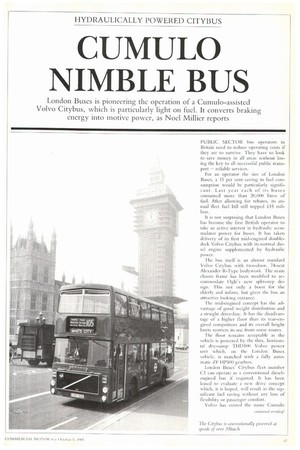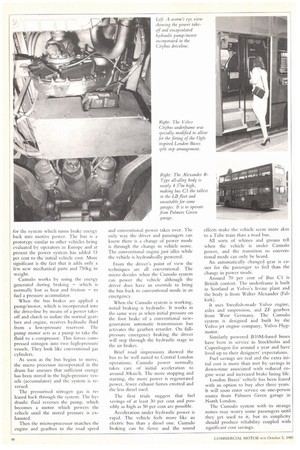CUMULO NIMBLE BUS
Page 65

Page 66

If you've noticed an error in this article please click here to report it so we can fix it.
London Buses is pioneering the operation of a Cumulo-assisted Volvo Citybus, which is particularly light on fuel. It converts braking energy into motive power, as Noel Millier reports
PUBLIC SECTOR bus operators in Britain need to reduce operating costs if they are to survive. They have to look to save money in all areas without losing the key to all successful public transport — reliable services.
For an operator the size of London Buses, a 15 per cent saving in fuel consumption would be particularly significant. Last year each of its buses consumed more than 20,00(1 litres of fuel. After allowing for rebates, its annual fleet fuel bill still topped .05 million.
It is not surprising that London Buses has become the first British operator to take an active interest in hydraulic accumulator power for buses. It has taken delivery of its first mid-engined doubledeck Volvo Citybus with its normal diesel engine supplemented by hydraulic power.
The bus itself is an almost standard Volvo Citybus with two-door, 74-seat Alexander R-Type bodywork. The main chassis frame has been modified to acCOM ITIodate Ogles new split-step design. This not only a boon for the elderly and infirm, but gives the bus an attractive looking entrance.
The mid-engined concept has the advantage of good weight distribution and a straight drive-line. It has the disadvantage of a higher floor than its rear-engined competitors and its overall height limits restricts its use from some routes.
The floor remains acceptable as the vehicle is powered by the thin, horizontal dry-sump THI)1110 Volvo power unit which, on the london Buses vehicle, is matched with a fully automatic ZF FIP500 gearbox.
London Buses' Citybus fleet number CI can operate as a conventional dieselengined bus if required. It has been leased to evaluate a new drive concept which, it is hoped, will result in the significant fuel saving without any loss of flexibility or passenger comfort.
Volvo has coined the name Cumulo for the system which turns brake energy back into motive power. The bus is a prototype similar to other vehicles being evaluated by operators in Europe and at present the power system has added 15 per cent to the initial vehicle cost. More significant is the fact that it adds only a few new mechanical parts and 750kg in weight.
Cumulo works by using the energy generated during braking — which is normally lost as heat and friction — to fuel a pressure accumulator.
When the bus brakes are applied a pump/motor, which is incorporated into the drive-line by means of a power takeoff and clutch to isolate the normal gearbox and engine, receives hydraulic fluid from a low-pressure reservoir. The pump motor acts as a pump to take the fluid to a compressor. This forces compressed nitrogen into two high-pressure vessels. They look like conventional gas cylinders.
As soon as the bus begins to move, the micro processor incorporated in the drum bar assesses that sufficient energy has been stored in the high-pressure vessels (accumulator) and the system is reversed.
The pressurised nitrogen gas is released back through the system. The hydraulic fluid reverses the pump, which becomes a motor which powers the • vehicle until the stored pressure is exhaus ted .
Then the micro-processor matches the engine and gearbox to the road speed and conventional power takes over. The only way the driver and passengers can know there is a change of power mode is through the change in vehicle noise. The conventional engine just idles while the vehicle is hydraulically powered.
From the driver's point of view the techniques are all conventional. The micro decides when the Cumulo system can power the vehicle although the driver does have an override to bring the bus hack to conventional mode in an emergency.
When the Cumulo system is working, initial braking is hydraulic. It works in the same way as when initial pressure on the foot brake of a conventional newgeneration automatic transmission bus activates the gearbox retarder, On fullpressure emergency braking the driver will step through the hydraulic stage to the air brakes.
Brief road impressions showed the bus to be well suited to Central London operations; Cumulo power normally takes care of initial acceleration to around 30km/h. The more stopping and starting, the more power is regenerated power, fewer exhaust fumes emitted and the less diesel used.
The first trials suggest that fuel savings of at least 30 per cent and possibly as high as SO per cent are possible.
Acceleration under hydraulic power is rapid. The vehicle feels more like an electric bus than a diesel one. Cumulo braking can be fierce and the sound effects make the vehicle seem more akin to a Tube train than a road bus.
All sorts of whines and groans tell when the vehicle is under Cumulo power, and the transition to conventional mode can only be heard.
An automatically changed gear is easier for the passenger to feel than the change in power mode.
Around 70 per cent of Bus Cl is British content. The underframc is built in Scotland at Volvo's Irvine plant and the body is from Walter Alexander (Falkirk).
It uses Swedish-made Volvo engine, axles and suspension, and ZF gearbox from West Germany. The Cumulo system is designed and built by the Volvo jet engine company, Volvo Flygmotor.
Similarly powered B10M-based buses have been in service' in Stockholm and Copenhagen for around a year and have lived up to their designers' expectations.
Fuel savings are real and the extra initial cost is more than met by savings in down-time associated with reduced engine wear and increased brake lining life.
London Buses' vehicle has been leased with an option to buy after three years. It will soon enter service on one-person routes from Palmers Green garage in North London.
The Cumulo system with its strange noises may worry some passengers until they get used to it, hut its simplicity should produce reliability coupled with significant cost savings.












































































































